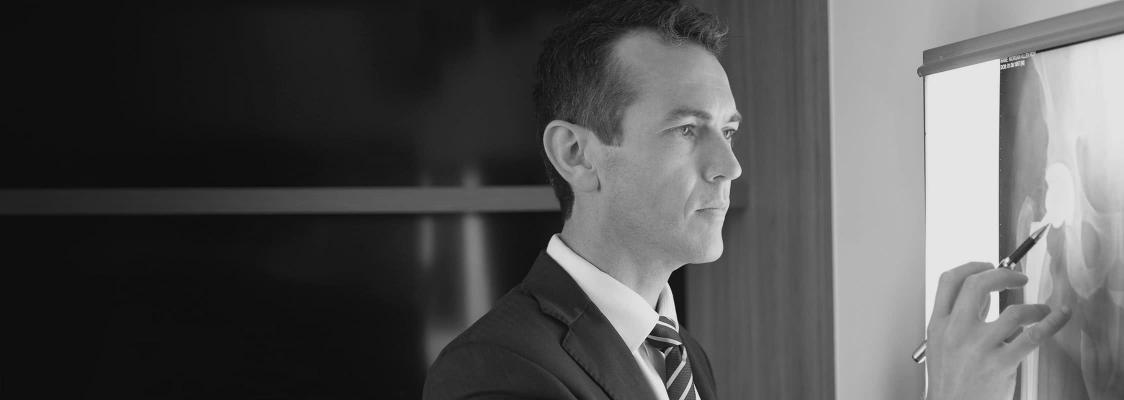Each knee joint contains two specialised fibrocartilage structures called the Meniscal cartilages. On the inner side (where the knees would touch against each other) lies the Medial Meniscus whilst the Lateral Meniscus lies on the outside. The Meniscal cartilages are crescent shaped and lie within the joint itself, interposed between the end of the Femur (thigh bone) and the top of the Tibia (shin bone).
They fulfill multiple functions - acting as shock absorbers across the knee joint, diminishing and spreading loading forces, providing “proprioception” sensory feedback of the position and loading of the knee joint and also helping to stabilise the joint.
The vital role of the meniscal cartilages to the health and function of the knee joint is unfortunately all too often demonstrated in people who sustained meniscal injuries in their youth (at a time when the importance of meniscal function was under-appreciated) and underwent complete meniscal resection surgery, only to develop very significant and premature osteoarthritis of the knee at a correspondingly young age. Thankfully, this approach to meniscal injury has now been abandoned (but was frequently performed up until the mid-1980s) and complete meniscal removal surgery is not performed these days.
The meniscus cartilages can become “pinched” within the knee joint during twisting, stumbling or jarring injuries of the knee and this can result in these structures being torn. Meniscus tears often cause sharp, stabbing pain at the side of the joint during twisting actions (even rolling over in bed). Injury to the Medial Meniscus (inner aspect of knee) are more common than injury of the Lateral Menicus (outer side of knee).
Meniscal tears commonly occur in atheletes who playing pivoting sports (football, basketball and skiing). They can also occur with simple stumbles whilst undertaking simple activities such as walking or gardening. Twisiting around whilst in a deep squat (eg. when working under a bench or changing a tyre) is a common mechanism of injury. A painful crack can often be heard or felt within the knee. In some severe forms of meniscus tear (called a “bucket handle tear”) the knee joint itself can become jammed or locked with the knee unable to fully straighten. This is called a “locked knee”.
Depending on patient age, activity level, symptom and injury severity, the first line management for a minor meniscus tear/injury is often rest, non-steroid anti-inflammatory medication and physiotherapy rehabilitation. A splint for knee support and comfort can be used while the injury settles, however this is not always required. The symptoms of a meniscus tear can settle over time but because the meniscus cartilages have very poor healing ability (due to minimal blood supply), the meniscus tear itself very rarely heals. Symptoms can occur with twisting and pivoting motions and long-term treatment may consist of simply avoiding these motions.
More significant or symptomatic meniscal tears often remain symptomatic indefinitely unless they are treated surgically via Knee Arthroscopy “keyhole” surgery. In most instances the torn section of meniscus cartilage is trimmed and removed, with the remaining healthy portion of the meniscus (usually the vast quantity of meniscus tissue) left alone to continue its normal functions. Usually, only a small section of the meniscus is torn (therefore, only a small portion requires removal).
In some situations, the meniscus is repaired rather than removed. Meniscal repair is advocated in younger patients and when the meniscal tear is very large or is of certain specific configuration (Meniscal root tear or RAMP tear).
The location, pattern and extent of meniscus tear as well as activity level, severity of symptoms and age of patient will determine the need and timing for any surgery.
Following meniscal surgery, postoperative treatment can vary widely. Postoperative management is primarily based upon the type of surgery performed.
If “trimming” or partial resection of the meniscus is all that has been performed, then immediate full weight bearing and full range of motion of the knee is allowed. Physiotherapy is advised to start immediately.
If, on the other hand, any form of meniscus repair has been performed, there are usually restrictions to weight bearing, range of motion, or both. The exact directions are individualized on a case-by-case basis and are based upon the type of repair performed and also the strength of the repair achieved.
Physiotherapy rehabilitation is advised for all episodes of meniscus injury and following any meniscal surgery. This will aid in the long-term by decreasing the risk of re-injuring the meniscus or knee again. Return to sport will be dependent upon the extent of the injury and symptoms as well as the type of sporting activity.
For more information regarding the surgery for meniscus tears, please refer to the sections entitled Knee Arthroscopy Surgery and Meniscus Repair Surgery.
